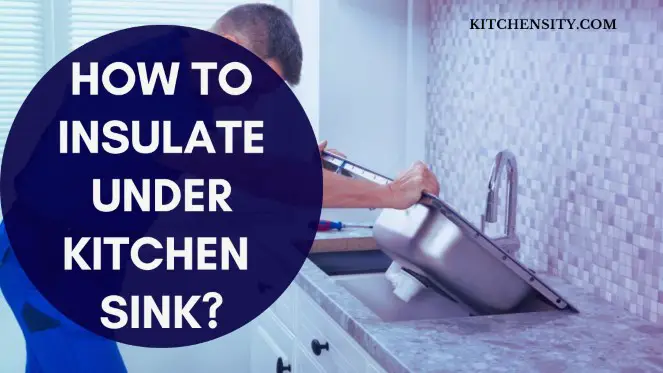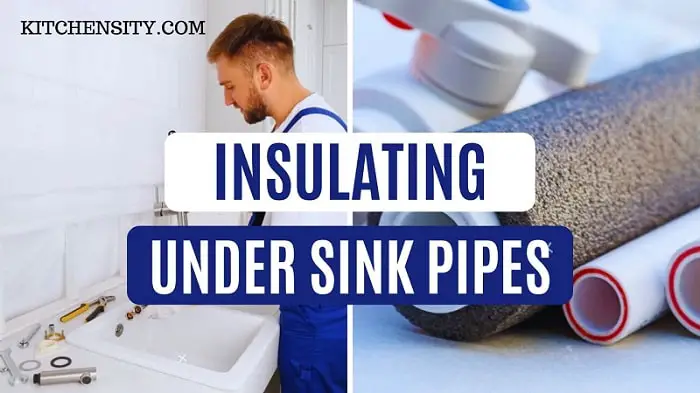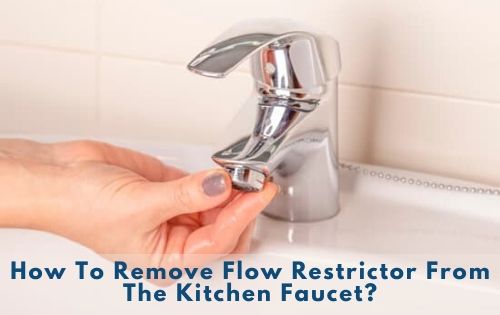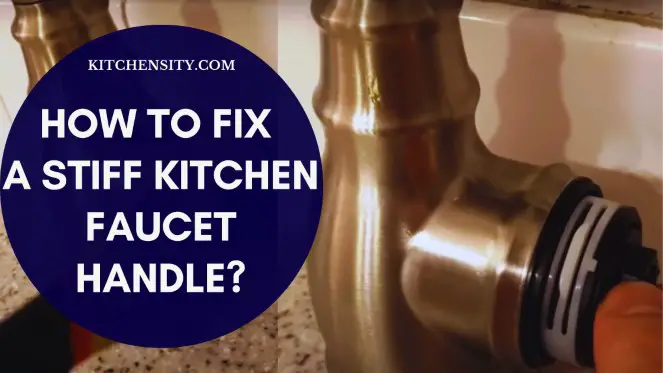Are you tired of hearing your pipes clanging every time you use your kitchen sink?
Do you want to prevent heat loss and save energy?
Then, it’s time to insulate the area under your kitchen sink!
Insulating your pipes and sink can help reduce noise, prevent leaks, and keep your kitchen warmer.
In this article, we will provide a step-by-step guide on how to insulate under the kitchen sink and discuss the benefits of proper insulation.
We will also provide tips on how to choose the right insulation material and answer some common questions about insulating under the kitchen sink.
So, let’s get started!

Table of Contents
- 1 How to Insulate Under Kitchen Sink?
- 2 Why Insulate Under Kitchen Sink?
- 3 How To Choose The Right Insulation Material?
- 4 Steps To Insulate Under Kitchen Sink:
- 5 Benefits Of Insulating Under The Kitchen Sink
- 6 Tips for Better Insulation:
- 7 Some Additional Tips:
- 8 You May Also Like
- 9 Conclusion
- 10 Frequently Asked Questions (FAQs)
- 10.1 Do I Need To Insulate Under My Kitchen Sink?
- 10.2 What Type Of Insulation Should I Use?
- 10.3 How Much Insulation Do I Need?
- 10.4 How Much Will This Project Cost?
- 10.5 How Long Will This Project Take?
- 10.6 Is It Safe To Handle Insulation Material?
- 10.7 Can I Do It Myself Or Do I Need To Hire A Professional?
- 10.8 What Do You Line Under A Sink With?
- 10.9 Should You Wrap Pipes Under The Kitchen Sink?
How to Insulate Under Kitchen Sink?
To insulate under the kitchen sink, you will need to follow these steps:
- Remove all items stored under the sink.
- Clean the area under the sink thoroughly.
- Measure the area to determine how much insulation material is needed.
- Choose the right insulation material based on factors such as R-value, moisture resistance, and budget.
- Cut the insulation material to fit the space under the sink.
- Install the insulation material, making sure it is snugly fit and does not leave any gaps.
- Replace any items that were stored under the sink.
Properly insulating the kitchen sink can provide benefits such as improved energy efficiency, reduced noise levels, and prevention of water damage.
It is a simple DIY project that can be completed in a few hours with the right materials and tools.
Check below for detailed instructions.
Also Read – Can You Use Loft Insulation Under Kitchen Cabinets?
Why Insulate Under Kitchen Sink?
Insulating under your kitchen sink offers several benefits.
- First, it can help reduce the noise caused by running water or banging pipes.
- Second, it can prevent heat loss, which can save energy and reduce your heating bills.
- Lastly, it can prevent leaks and moisture buildup, which can lead to mold and other damage.
How To Choose The Right Insulation Material?
Choosing the right insulation material for under the kitchen sink depends on various factors, such as the size of the space, the level of insulation needed, and the budget.
Here are some factors to consider when choosing the right insulation material:
- R-value: The R-value measures the insulation material’s ability to resist heat flow. The higher the R-value, the better the insulation material’s thermal performance.
- Type of insulation: There are different types of insulation materials, such as fiberglass batts, spray foam, and rigid foam boards. Each material has its pros and cons, such as cost, ease of installation, and performance.
- Moisture resistance: In a kitchen, there is a risk of moisture and water damage, so it’s essential to choose a moisture-resistant insulation material.
- Fire resistance: Some insulation materials are more fire-resistant than others. If safety is a concern, consider using insulation material with a higher fire resistance rating.
- Environmental impact: Consider the environmental impact of the insulation material. Some materials, such as spray foam, may release harmful chemicals during installation, while others, such as recycled denim insulation, are more eco-friendly.
- Budget: The cost of insulation materials can vary significantly. Consider the budget and weigh the benefits of the different types of insulation materials.
By considering these factors, you can choose the right insulation material that meets your specific needs and provides the best performance for insulating under the kitchen sink.
Steps To Insulate Under Kitchen Sink:
Materials Required
To insulate under your kitchen sink, you’ll need the following materials:
- Measuring tape
- Ruler
- Utility knife
- Insulation material (foam board, fiberglass batts, or spray foam)
- Insulation tape or duct tape
- Safety goggles
- Dust mask
- Gloves
Measuring The Area
- Before you start insulating, measure the area under your kitchen sink to determine how much insulation material you’ll need.
- Use a measuring tape or ruler to measure the length, width, and height of the space.
- Write down the measurements and add a few extra inches to ensure you have enough insulation material.
Preparing The Materials
Once you have the measurements, it’s time to prepare the insulation material.
If you’re using foam board or fiberglass batts, cut them to fit the measured space using a utility knife.
If you’re using spray foam, shake the can well and follow the manufacturer’s instructions.
Insulating The Under Sink Pipes
Insulating the pipes is an important part of insulating your kitchen sink area.
Pipes that are not insulated can lose a significant amount of heat, leading to energy loss and increased energy bills.
Additionally, uninsulated pipes can be more prone to freezing during the winter months, which can cause them to burst and result in costly repairs.
Fortunately, insulating pipes is a relatively simple and inexpensive process. Here are the steps you can follow to insulate the pipes under your kitchen sink:

Step 1: Choose the Right Insulation Material
- There are several types of insulation material that you can use to insulate your pipes, including foam insulation, fiberglass batts, and pipe sleeves.
- Foam insulation is best for pipes that run along flat surfaces, while fiberglass batts are better suited for pipes that run along irregular surfaces.
- Pipe sleeves are pre-formed tubes that can be slipped over the pipes to insulate them.
Step 2: Measure and Cut the Insulation Material
- Measure the length of the pipes you want to insulate and cut the insulation material to the appropriate length.
- Be sure to leave enough room around any bends in the pipes to ensure that the insulation fits snugly.
Step 3: Install the Insulation Material
- Slide the insulation material over the pipes, making sure that it fits snugly and is not loose or sagging.
- Use duct tape or zip ties to secure the insulation material in place and seal any gaps or seams.
Step 4: Insulate the Pipe Fittings
- Don’t forget to insulate the pipe fittings as well, as they can also contribute to heat loss.
- Use foam insulation or pipe sleeves to cover any exposed pipe fittings.
Step 5: Reattach the Pipes
- Once the insulation material is in place, reattach the pipes to their original positions.
- Make sure that all connections are tight and secure.
Insulating your pipes is a simple and effective way to improve the energy efficiency of your kitchen sink area.
By following these steps, you can reduce heat loss, prevent frozen pipes, and save money on your energy bills.
Insulating The Sink
Insulating the sink is another important aspect of insulating your kitchen sink area.
A poorly insulated sink can result in heat loss, water damage, and increased noise levels.
By insulating your sink, you can prevent these problems and enjoy a more comfortable and efficient kitchen.
Here are the steps you can follow to insulate your sink:
Step 1: Choose the Right Insulation Material
- There are several types of insulation material that you can use to insulate your sink, including foam board, spray foam, and fiberglass batts.
- Foam board is best for flat surfaces, while spray foam is great for hard-to-reach areas.
- Fiberglass batts are best for irregular surfaces.
Step 2: Measure and Cut the Insulation Material
- Measure the area under your sink and cut the insulation material to fit.
- Be sure to leave enough space around any pipes or other obstacles.
Step 3: Install the Insulation Material
- Place the insulation material under the sink and secure it in place with adhesive or tape.
- Be sure to cover all exposed surfaces, including the bottom and sides of the sink.
Step 4: Seal Any Gaps or Cracks
- Use spray foam or caulk to seal any gaps or cracks around the sink.
- This will prevent air leaks and water damage.
Step 5: Insulate the Pipes
Don’t forget to insulate the pipes under the sink as well. Follow the steps outlined in the previous section to insulate your pipes.
Insulating your sink is an important step in creating a more energy-efficient and comfortable kitchen.
By choosing the right insulation material, measuring and cutting the material to size, installing the insulation material, sealing any gaps or cracks, and insulating the pipes, you can ensure that your sink is properly insulated and reduce heat loss, water damage, and noise levels.
Also Read – What Can I Put Under My Kitchen Sink to Protect My Cabinets?
Benefits Of Insulating Under The Kitchen Sink
- Improved energy efficiency: Insulating under the sink can help to reduce heat loss and improve the energy efficiency of your home. This can help to lower your energy bills and reduce your carbon footprint.
- Reduced noise levels: Insulation can help to absorb sound and reduce noise levels, which can be particularly beneficial if your kitchen is located near living or sleeping areas.
- Prevented water damage: Insulation can help to prevent water damage by preventing condensation from forming on the underside of the sink. This can help to prevent mold and mildew growth and prolong the lifespan of your cabinets.
- Improved indoor air quality: Insulation can help to prevent air leaks, which can improve indoor air quality by preventing pollutants and allergens from entering your home.
- Enhanced comfort: Insulation can help to create a more comfortable kitchen by reducing drafts and maintaining a more consistent temperature.
Overall, insulating under the kitchen sink can provide a range of benefits that can help to improve the efficiency, comfort, and safety of your home.
Tips for Better Insulation:
Seal The Gaps:
- To ensure maximum insulation, it’s important to seal all gaps and cracks around the pipes and sink.
- Use insulation tape or duct tape to cover any gaps or holes.
Use The Right Insulation Material:
- Choose the right insulation material for your needs.
- Foam board is best for walls and flat surfaces, while fiberglass batts are best for pipes and irregular surfaces.
- Spray foam is great for hard-to-reach areas.
Keep Safety In Mind:
- Always wear safety goggles, gloves, and a dust mask when handling insulation material.
- Keep the area well-ventilated and avoid contact with skin or eyes.
Some Additional Tips:
- If you have access to the pipes behind the sink, you can insulate them as well. This will help to prevent them from freezing in the winter.
- If you are using spray foam insulation, be sure to follow the manufacturer’s instructions carefully. Spray foam can be very messy, so it is important to take precautions to protect your kitchen from spills.
- Once the insulation is installed, you may want to add a layer of reflective foil to the inside of the cabinet. This will help to reflect heat into the cabinet and keep your kitchen even warmer.
You May Also Like
- How To Clean Plastic Kitchen Sink?
- Tighten A Loose Moen Single Handle Kitchen Faucet & Base [3 Steps]
- How To Remove Flow Restrictor From The Kitchen Faucet?
- How To Remove Kitchen Faucet Without Basin Wrench?
- 6 Pull-Out Spray Kitchen Faucet Problems That Are Easy To Fix
- How To Unclog A Sink Clogged With Coffee Grounds?
Conclusion
Insulating under kitchen cabinets can provide a range of benefits, including improving energy efficiency, reducing noise levels, preventing water damage, and improving indoor air quality.
To insulate under kitchen cabinets, one can use a range of materials, including fiberglass batts, spray foam, or rigid foam board, depending on the specific needs of the space.
It is also important to properly seal any gaps or cracks and to insulate any pipes in the area.
By following these steps, homeowners can enjoy a more comfortable and efficient kitchen, while also reducing their energy bills and helping to protect the environment.
Frequently Asked Questions (FAQs)
-
Do I Need To Insulate Under My Kitchen Sink?
Yes, insulating under your kitchen sink can help reduce noise, prevent heat loss, and prevent leaks and moisture buildup.
-
What Type Of Insulation Should I Use?
There are a variety of insulation materials that can be used for this project, including fiberglass batts, mineral wool, and spray foam.
Each type has its advantages and disadvantages, so it is important to choose the right type for your project.
Foam board is best for walls and flat surfaces, while fiberglass batts are best for pipes and irregular surfaces. Spray foam is great for hard-to-reach areas. -
How Much Insulation Do I Need?
The amount of insulation you need will depend on the size of the space under your sink. You can usually find the dimensions of your sink cabinet on the manufacturer’s website.
Once you know the dimensions of the cabinet, you can calculate the amount of insulation you need using the following formula:
Length x Width x Height = Volume -
How Much Will This Project Cost?
The cost of this project will vary depending on the type of insulation you use and the size of the space under your sink.
-
How Long Will This Project Take?
This project can be completed in about an hour or may take the entire day, depending on the size of the space under your sink and your level of experience.
-
Is It Safe To Handle Insulation Material?
No, insulation material can be harmful if it comes into contact with skin or eyes. Always wear safety goggles, gloves, and a dust mask when handling insulation material.
-
Can I Do It Myself Or Do I Need To Hire A Professional?
You can do it yourself, but if you’re not comfortable working with insulation material, it’s best to hire a professional.
-
What Do You Line Under A Sink With?
A sink can be lined with insulation material, such as foam board, spray foam, or fiberglass batts, to prevent heat loss, water damage, and noise levels.
-
Should You Wrap Pipes Under The Kitchen Sink?
Yes, it is recommended to wrap pipes under the kitchen sink with insulation material to prevent heat loss and to protect against freezing. Insulating pipes can also help to reduce noise levels and prevent water damage.
Katrina Smith is a seasoned expert with over 25 years of experience in all things related to cooking and the kitchen. As an avid cook and kitchen enthusiast, she is passionate about sharing her knowledge and expertise on cookware, kitchen appliances, kitchen tips, and kitchen staples.
Through her articles and reviews, Katrina aims to inspire and help others improve their cooking skills, experiment with different ingredients, and invest in quality cookware and appliances.

![How To Unclog A Sink Clogged With Coffee Grounds? [3 Effective Ways] 4 How-to-Unclog-a-Sink-Clogged-With-Coffee-Grounds](https://www.kitchensity.com/wp-content/uploads/2020/06/How-to-Unclog-a-Sink-Clogged-With-Coffee-Grounds.jpg)

![Best Insulation Under The Kitchen Sink [3 Top Insulations] 6 Best Insulation Under The Kitchen Sink](https://www.kitchensity.com/wp-content/uploads/2023/04/Best-Insulation-Under-The-Kitchen-Sink.jpg)


